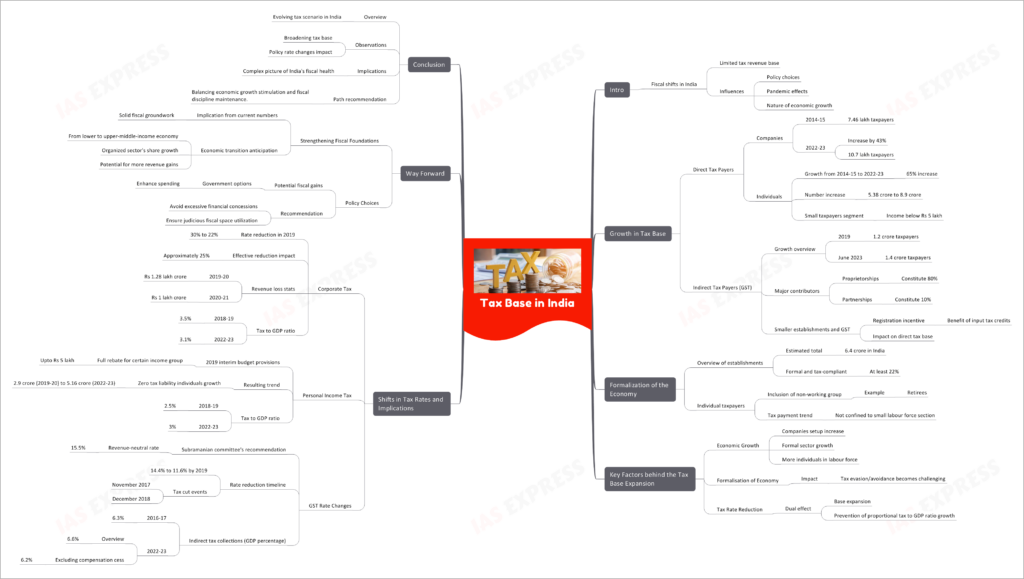Tax Base in India- Trends, Reasons & Challenges
From Current Affairs Notes for UPSC » Editorials & In-depths » This topic
IAS EXPRESS Vs UPSC Prelims 2024: 85+ questions reflected
In the recent times, despite a limited tax revenue base, the Indian government’s fiscal space has witnessed some significant shifts. Interestingly, these shifts aren’t just due to rapid economic growth but are closely interlinked with policy choices, the pandemic, and the nature of economic growth.

Growth in Tax Base
Direct Tax Payers
- Companies:
- 2014-15: 7.46 lakh companies were paying tax.
- 2022-23: This increased by 43% to 10.7 lakh companies.
- Individuals:
- Growth of 65% from 2014-15 to 2022-23.
- Number increased from 5.38 crore to 8.9 crore.
- Notably, a large segment comprises small taxpayers with incomes below Rs 5 lakh.
Indirect Tax Payers (GST)
- Growth witnessed in the number of GST payers:
- 2019: 1.2 crore
- June 2023: 1.4 crore
- Significant contributors:
- 80% are proprietorships.
- 10% are partnerships.
- Smaller establishments have shown interest in registering under GST for the benefit of input tax credits, which also likely affects the direct tax base.
Formalization of the Economy
- With an estimated 6.4 crore establishments in India, at least 22% are formal and tax-compliant.
- Despite a large number of individual taxpayers, the formal labour force’s percentage might be lower due to the inclusion of non-working taxpayers, like retirees.
- The data suggests that paying income tax isn’t confined to a small part of the labour force anymore.
Key Factors behind the Tax Base Expansion
- Economic Growth:
- Increase in the number of companies.
- Growth in the formal sector.
- Larger number of individuals joining the labour force.
- Formalisation of Economy: Makes tax evasion or avoidance more difficult.
- Reduction in Tax Rates: While aiding in expanding the base, it also prevented a proportional rise in the tax to GDP ratio.
Shifts in Tax Rates and Implications
Corporate Tax
- 2019 saw a reduction in corporate tax from 30% to 22%.
- This amounted to an effective reduction of approximately 25%.
- Resulted in revenue loss: Rs 1.28 lakh crore (2019-20) and Rs 1 lakh crore (2020-21).
- Tax to GDP ratio:
- 2018-19: 3.5%
- 2022-23: 3.1%
Personal Income Tax
- 2019 interim budget introduced a full rebate for individual taxpayers with income up to Rs 5 lakh.
- Result: Rise in zero tax liability individuals from 2.9 crore (2019-20) to 5.16 crore (2022-23).
- Personal income tax to GDP ratio:
- 2018-19: 2.5%
- 2022-23: 3%
GST Rate Changes
- Subramanian committee’s recommended revenue-neutral rate: 15.5%.
- Weighted average GST rate saw a reduction from 14.4% to 11.6% by 2019 due to tax cuts in November 2017 and December 2018.
- Indirect tax collections as a percentage of GDP:
- 2016-17: 6.3%
- 2022-23: 6.6% (excluding compensation cess revenue, it was 6.2%).
Way Forward
- Strengthening Fiscal Foundations: The numbers hint at solid fiscal groundwork, and with the economic upturn, as India aims to transition from a lower to an upper-middle-income economy and the organized sector’s share rises, more revenue gains are anticipated.
- Policy Choices: These potential gains provide the government with the option to enhance spending without compromising fiscal health. The government should be cautious and avoid excessive financial concessions, ensuring a judicious utilization of this fiscal space.
Conclusion
India’s evolving tax scenario, marked by a broadening base yet affected by policy rate changes, paints a complex picture of the country’s fiscal health. While challenges remain, a strategic path forward can ensure a balance between stimulating economic growth and maintaining fiscal discipline.
Practice Question for Mains
Why is the tax revenue increasing in India? Discuss how it can be used to aid economic growth in India. (250 words)
If you like this post, please share your feedback in the comments section below so that we will upload more posts like this.

